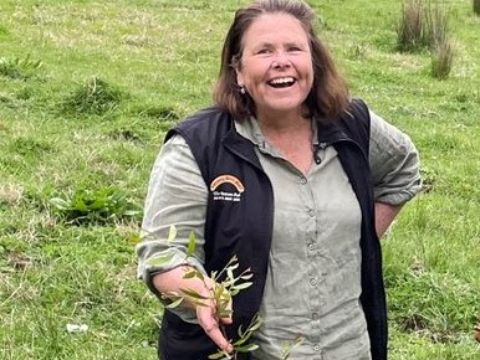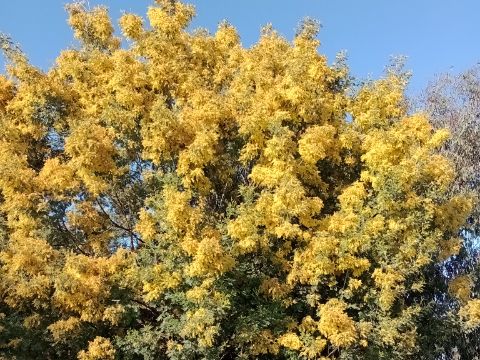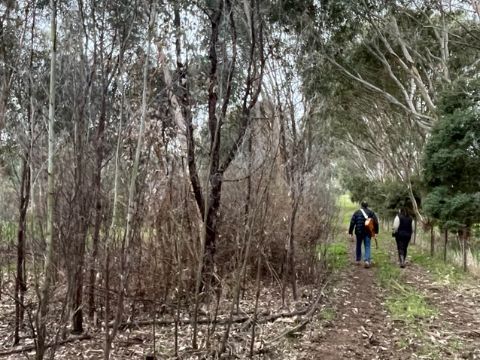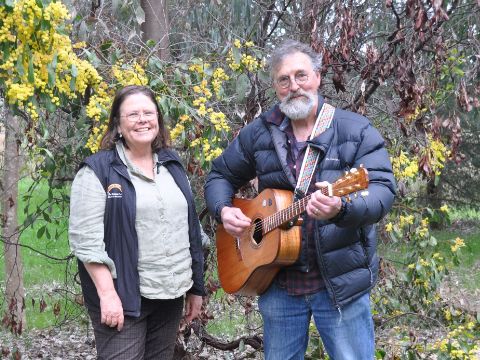By Lecturer in Environmental Management Dr Alexandra Knight (pictured below) in the Charles Sturt School of Agricultural, Environmental and Veterinary Sciences and a researcher in the Charles Sturt Gulbali Research Institute of Agriculture, Water and Environment.
It’s Wattle Day on Friday 1 September, a commemoration of Australia’s national floral emblem, and friends and I celebrate it with a special song.
 Varying attitudes to wattles exist in Australia, all of which I’ve experienced on my property on Dhudhuroa Country in north-eastern Victoria, with some people loving them, some farmers not liking them, and some people fearing that they will be fuel for future bushfires.
Varying attitudes to wattles exist in Australia, all of which I’ve experienced on my property on Dhudhuroa Country in north-eastern Victoria, with some people loving them, some farmers not liking them, and some people fearing that they will be fuel for future bushfires.
The wider landscape I live in is over-cleared, like most of the endangered Grassy Box Woodland of eastern Australia of which less than four per cent remains in its original condition, because it’s productive grazing country.
When I bought my 12 hectares 20 years ago there were only three mature native trees here and I started revegetating my property immediately as I am committed to a sustainable future and supporting Australian nature.
Since then, with my friends, neighbours and Landcare group we’ve covered parts of it with gums and wattles to contribute to restoring a healthy landscape that brings wellbeing to humans and Australian wildlife.
Consequently, my land has been covered in the brilliant yellow flowers of golden wattle, silver wattle, varnish wattle and red stem wattle for a few weeks now, brightening even the dullest and coldest winter days. It’s beautiful, it smells amazingly fresh and is full of vigour and life; my place has gone from being empty to being full of insects and birds.
 The start of this 20-year project was my first area of revegetation, a small triangle with a mature hollow-bearing tree in it in 2003 which my Charles Sturt environmental science students helped me fence off and plant with tube-stock.
The start of this 20-year project was my first area of revegetation, a small triangle with a mature hollow-bearing tree in it in 2003 which my Charles Sturt environmental science students helped me fence off and plant with tube-stock.
In 2007 I received a small grant from North East Catchment Management Authority (NECMA) and planted more tube-stock and also tried some ‘direct seeding’ where multiple varieties of wattles and gums were planted by seed, after I fenced areas and controlled the weeds.
Despite the terrible millennium drought, it was very successful. I did a lot of watering by hand to keep the young trees alive, and subsequently I hand-planted more tube-stock. In 2013 I received a more substantial grant with the help of Landcare, direct seeding my middle paddock and parts of my end paddock.
Ten years later it's looking terrific (see video: https://youtu.be/oxWbv8bbHQ8?si=adDDElnJN-5L3mhO ), and I’ve added to it each year on Tree Day.
Not only do I have lots of trees and shrubs, I have a huge increase in the variety of birds and other wildlife living at my place, despite the lack of trees on properties that surround it. While I still have stock on my property, I have stabilised erosion and created a nature haven.
 But there are some ill-informed attitudes towards wattles in my area that have caused me a major problem in April 2023 when the contractor I employed to spray my blackberries came while I was out and decided to also spray some of the revegetation that was well away from the blackberries.
But there are some ill-informed attitudes towards wattles in my area that have caused me a major problem in April 2023 when the contractor I employed to spray my blackberries came while I was out and decided to also spray some of the revegetation that was well away from the blackberries.
By the time I got home he had been spraying for three hours and hadn’t done most of the blackberries yet. I ran across the paddock and discovered he had sprayed a lot of my mid-storey species including wattles (I have eight species) and hop bushes.
I asked him about it and he told me that he ‘didn’t like wattles’ and said some of it had been sprayed hard and would die (pictured left), and some of the gum trees would die as well from spray drift.
I was completely devastated and for a couple of weeks it felt like my life’s work had been destroyed. I despaired of the world and not just for my wattles, but for the environmental decline all around us, and for the young people that I teach, some of whom are living with environmental despair.
“My friends and community helped me. Hugh, from our local Landcare group, came out and examined the damage and told me not to give up. One friend, Lynne, encouraged me to plant more, and keep planting so I have new wattles in; I planted and planted.”
 Another important way to heal grief is through creativity, so I popped up to my neighbours Peter, Narelle and Bella Klein and talked to Pete about writing a song. That’s been quite a journey and has been a strong part of the healing process.
Another important way to heal grief is through creativity, so I popped up to my neighbours Peter, Narelle and Bella Klein and talked to Pete about writing a song. That’s been quite a journey and has been a strong part of the healing process.
We’ve sung about wattles, we’ve sung about sadness and anger, we’ve sung about the choice Australians are making now about The Voice to Parliament and how important that is for Australia.
We’ve revised it and sung it again and again – it’s been fun, sad and full of emotion. And although some of my wattles are dead and there is a lot of work to clear, replant and remediate the soil, singing and creating a song together has been a wonderful journey of building hope.
Pete (pictured with Alex) has recorded 'Let the Wattle Grow' with the help of Jack, and we’re playing it on Wattle Day to encourage people to learn what an important part of the landscape Australian wattles are, and to encourage people to plant and grow wattle trees.
This is why wattles are so important:
- Australia’s national floral emblem is Golden Wattle (Acacia pycnantha) (pictured top) and gives us our national colours, green and gold.
- Of the 1,350 wattle species around the world, 1,000 are Australian.
- The leaves of most Acacia species are flattened leaf stalks called phyllodes. They are tough and leathery structures that are very resistant to moisture loss, making them one of the most drought tolerant plants you can get for garden or revegetation areas.
- Wattles are pioneer plants and their roots are the first to rapidly bind erosion prone soils following wildfires.
- Wattles fix atmospheric nitrogen in the soil. Other woodland species can rapidly utilise these increased nitrogen levels provided by the nodules of rhizobia bacteria present in their expansive root system.
- Wattles provide breeding sites for many bird species, such as Grey Fantails. They provide food sources to birds of all sizes from Thornbills to Black Cockatoos.
- The cracks and crevices in wattles’ bark provide homes for many beneficial insects.
- The tannin industry in the early 1900s thrived on tannic acid extracted from wattle bark. The logging of the wattle caused rapid deforestations of our woodlands. The highly valued tannins were used for tanning, plywood and particleboard adhesives and antiseptics. South Africa now has massive plantations of black wattle and Australia imports its tannin products from there.
- Wattle flowers provide very nitrogen-rich pollen. They attract pollen-feeding birds such as Wattle Birds, and Honey Eaters. The protein rich nectar in the leaf axials is very sustaining for nurturing the growth of juvenile nestlings and invertebrates like ants.






Social
Explore the world of social